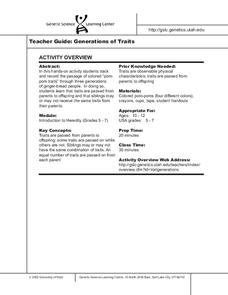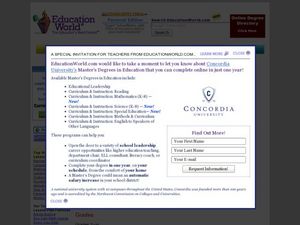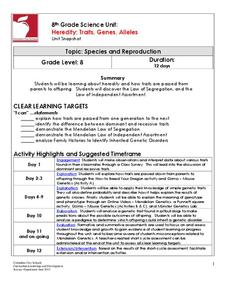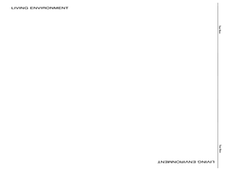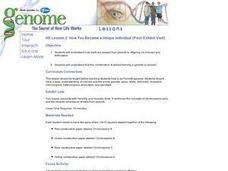Curated OER
Mother and Baby Animals 3
Young learners use a word bank to write the names of mother and baby animals next to their pictures. They complete four easy mazes which connect parents to babies.
Curated OER
Vocabulary 2c - Life Science: From Parents to Young
This life science vocabulary list and definitions will be useful when teaching a parent and offspring unit. Some nice ideas are included in the plan about the word origins, word structure and definition testing methods. There is also a...
Curated OER
Animal Offspring And Animal Parent
Students investigate the concept of animals and the relationship of parents and offspring. Students are immersed in the lesson with the help of animal books and stuffed animals. These are used to stimulate exploration and conversation.
Curated OER
Generations of Traits
In this biology worksheet, students track and record the passage of colored pom pom traits through three generations of ginger-bread people. Then they describe that traits are passed from parents to offspring and that siblings may or may...
Curated OER
Form and Observation
Use a familiar song and adorable baby animal pictures to teach youngsters about genetic variation. Begin by listening to "Twelve Variations on 'Ah vous dirai-je Maman,'" which you will need to find online (there are several versions...
Curated OER
Baby Animals Debut at Zoos
Students determine the names of animal babies, then read a news article about zoo's experiencing animal births. In this current events lesson, the teacher introduces the article with vocabulary activities, then students read the news...
Curated OER
Parental Genes
Eighth graders explore how different organisms pass their traits to their offspring. In this life science lesson, 8th graders differentiate recessive and dominant alleles. They predict the phenotype based on the genotype of an organism.
Curated OER
Animals and Animal Babies
Students examine how some animal young are similar to the adult. They look at pictures of various animals and their young and identify if they look similar or not similar to the adult animal, and draw a picture of a baby and parent...
Curated OER
Is That Your offspring?
In this animal worksheet, study the names of animal offspring. Students complete 2 word searches finding the offspring vocabulary in one and the parent names in the other.
Curated OER
A Prickle of Hedgehogs
Students, individually or in groups, conduct research to find information needed to complete a worksheet in which they must match an animal name with 1) the name of its offspring (dog-puppy) and 2) its animal group name (geese-gaggle.)
Curated OER
Genetically Inherited Traits
Students explore heredity by examining how traits are passed from parent to offspring. Genetic terminology is examined and examples of inherited traits discussed. calculating genetic probability is also investigated in this lesson.
Curated OER
How Are Offspring Like Their Parents?
In this parent and offspring worksheet, students complete a graphic organizer by writing in 1 idea and 2 supporting details about how offspring are like their parents.
Curated OER
Rock, Paper, Scissors - Dominant and Recessive Traits from Parent to Offspring
Fifth graders understand the meaning of dominant and recessive. In this dominant and recessive traits lesson, 5th graders participate in a game and record results on a chart. Students relate experiment to genes. Students describe plants...
Curated OER
Baby Animals
In this baby animal graphic organizer, students write in four examples of young animals that look like their parents, and two examples of young animals that look different from their parents.
Columbus City Schools
Heredity: Traits, Genes, Alleles
If you knew people would pay extra for a bald dragon, could you pick which parents you should breed in order to get the highest number? The unit examines heredity and genetics through breeding dragons, mice, dogs, and tries to figure...
Agriculture in the Classroom
Roll of the Genes
Animal reproduction in sheep and cattle is explored with the help of Punnet squares. Scholars employ tools using probability to conclude the color of wool a sheep's offspring will have. Acting as animal geneticists, pupils then take...
Curated OER
Regents High School Exam: Living Environment 2008
Tne New York Regents High School Examinations are comprehensive and include various styles of questions, includingmultiple choice and the analysis of graphs. This particular version, the 2008 Living Environment exam surveys a variety of...
US National Library of Medicine
Monster Genetics Lab
Harness young scientists' knowledge of genetics with an engaging science activity. Students start by flipping a coin to determine the genotypes and phenotypes of two parent monsters, before using Punnett squares to determine the...
Virginia Department of Education
Passing Traits to Offspring
What makes each one of us unique? Lead your class in this exciting and educational activity as you uncover traits that show how each individual is different from another. Pupils explore facts about DNA technology and predict the...
Curated OER
Reproduction and Development
Have a sense of humor when discussing human anatomy with your class! Through puzzles and riddles, learners become comfortable with words relating to reproduction and development. They combine mixed up words from the "vocabulary gene...
K20 LEARN
You're My 'Karyo'-Type: Karyotype For Chromosomal Disorders
What's your type? Genetically speaking, of course! Immerse your class in the world of karyotypes through an insightful activity from the K20 Center. Scholars take on the role of genetic counselors to determine the karyotype of offspring...
Curated OER
Activity: Gummy Bear Genetics
Who's your Daddy ... and Mommy for that matter? Given a first-generation group of gummy bear offspring, young scientists must determine which bears are their parents. An activity worksheet covers the differences in genotypes and...
Curated OER
Which Baby Animals Looks Unlike Their Parents?
Learners review the steps of the butterfly life cycle to show how the babies are different from the parents. This learning exercise is a graphic organizer with four fill in the blank statements.
Curated OER
How You Become a Unique Individual
Students investigate how traits are passed from parents to offspring via meiosis and fertilization. They recognize that the combination of alleles forming a gamete is random.
Other popular searches
- Baby Animals and Parents
- Animal Babies and Parents
- Animal Parents and Offspring
- Parents and Offspring Names





